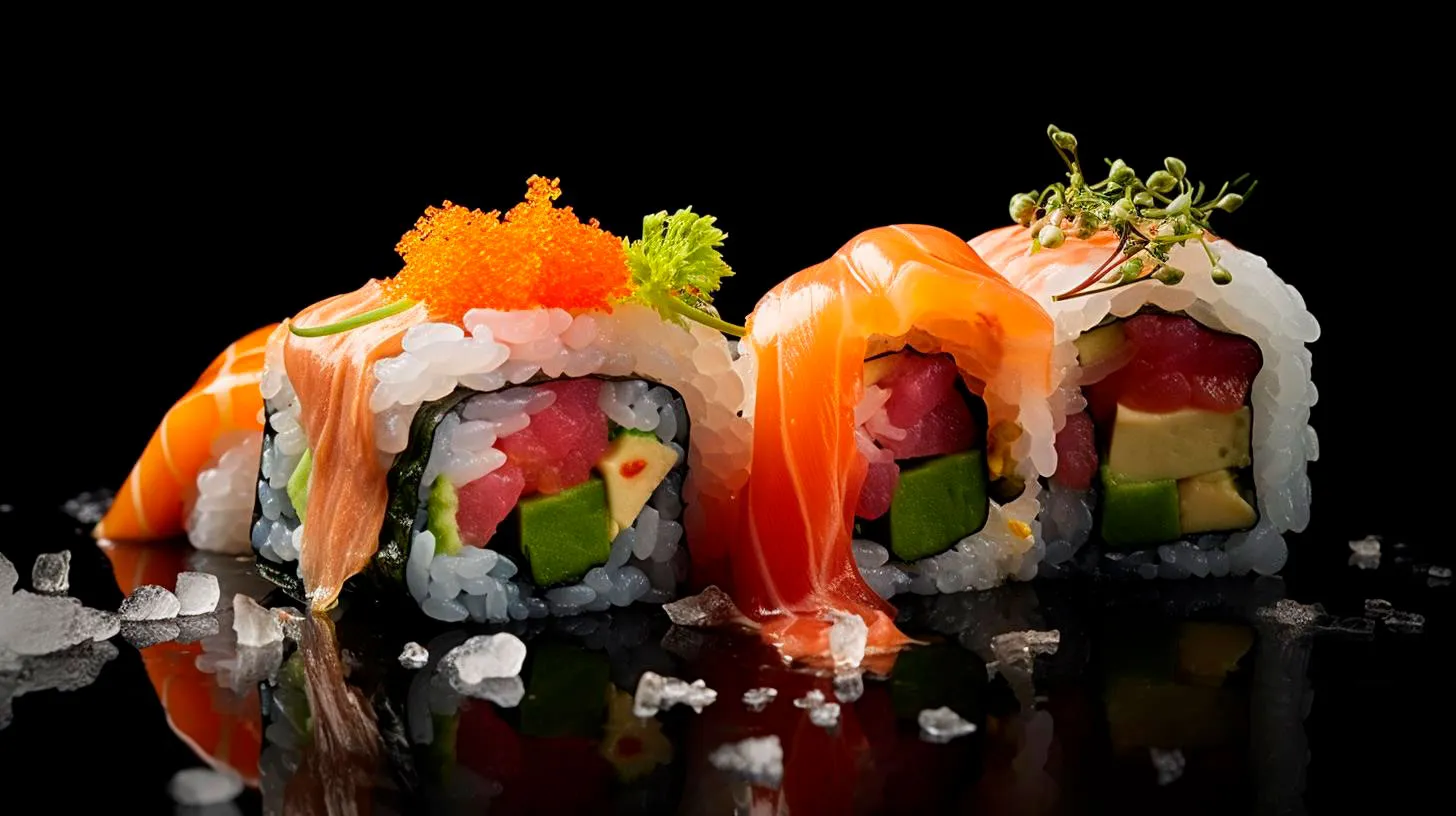Nori-Free Experimenting with Unconventional Wrapping Options for Sushi
By experimenting with unconventional wrapping materials, they are not only catering to dietary restrictions but also offering exciting new flavors and textures to sushi lovers worldwide.
Traditionally, nori is made from edible seaweed that is harvested, collected, and processed into thin sheets. It provides a distinctive taste, aroma, and appearance to sushi rolls. However, due to various factors such as allergies, personal preferences, or dietary restrictions, some individuals may need to avoid nori or simply desire a change in taste. That’s where the concept of nori-free sushi comes into play.
Alternative Wrapping Options for Sushi
Sushi chefs have been experimenting with a wide array of ingredients to replace nori, creating unique and exciting sushi rolls. Let’s explore some of the unconventional wrapping options taking the sushi world by storm:
- Rice Paper: This thin, translucent edible paper made from rice flour and water has become a popular alternative to nori. It offers a light and delicate texture, allowing the fillings of the sushi roll to take center stage. Rice paper is a gluten-free option that provides a neutral taste, making it versatile in pairing with various flavors.
- Cucumber: For those seeking a refreshing and low-carb option, thinly sliced cucumber acts as a fantastic replacement for nori. The vibrant green color and crisp texture enhance the overall sushi experience. Cucumber-wrapped sushi offers a refreshing crunch and is perfect for summer rolls or lighter options.
- Soy Paper: Made from soybean, soy paper is an excellent choice for people with seafood allergies or those avoiding gluten. It offers a slightly sweet and nutty flavor, adding an interesting twist to traditional sushi rolls. The vibrant colors of soy paper add visual appeal to sushi presentation.
- Collard Greens: For a healthier alternative, collard greens have emerged as a popular choice for wrapping sushi. These large, leafy greens provide a robust and slightly bitter taste that complements the flavors of sushi fillings. Collard greens are packed with nutrients, making them a great option for health-conscious sushi lovers.
- Fruit Slices: Yes, you read it right! Some sushi enthusiasts are experimenting with fruit slices as substitute wraps for sushi. Utilizing thinly sliced fruits like mango or pineapple adds a burst of sweetness to the sushi experience, creating intriguing flavor combinations that surprise and delight.
While nori remains the traditional and widely used wrapping for sushi, these alternative options allow for exciting variations that cater to different tastes and dietary requirements. Whether you’re looking for a gluten-free option, a lighter alternative, or simply a change of pace, these nori-free sushi options have something to offer.
Advantages of Nori-Free Sushi
Experimenting with unconventional wrapping options for sushi brings with it numerous benefits and unique selling points:
- Catering to Dietary Restrictions: Nori-free sushi options open up the world of sushi to individuals with dietary restrictions such as gluten intolerance, seafood allergies, or plant-based diets. It allows a wider range of customers to enjoy sushi.
- Exploring New Flavors: By using alternative wrapping options, sushi enthusiasts can experience diverse flavors that complement or contrast with the traditional taste of nori. This brings excitement and innovation to a much-loved cuisine.
- Enhancing Visual Presentation: Different wrapping materials add vibrant colors and unique visual appeal to sushi rolls. Presentation plays a crucial role in attracting customers, and the use of unconventional wraps can elevate the overall sushi experience.
- Creative Customization: Offering nori-free sushi provides sushi chefs and customers alike with the opportunity to get creative and customize their rolls. The possibilities are endless when it comes to combining various fillings and alternative wraps.
- Cross-Cultural Fusion: Incorporating unconventional wrapping options introduces cross-cultural fusions into sushi. For example, using rice paper as a wrap brings a touch of Vietnamese cuisine, while collard greens offer a southern twist. This fusion of flavors attracts a diverse audience.
Key Takeaways
As the sushi industry evolves, experimenting with new and unconventional wrapping options opens up a world of possibilities. The introduction of nori-free sushi caters to different dietary restrictions, adds exciting flavors and textures, enhances visual appeal, encourages creativity, and brings about the fusion of various culinary traditions.
So, the next time you’re craving sushi or looking to surprise your taste buds, don’t hesitate to try a nori-free roll. You might just discover a new favorite way to enjoy this beloved Japanese delicacy.
Beyond Nori: Unveiling Exciting Sushi Roll Wrapping Options
However, in recent years, sushi enthusiasts and chefs have started exploring beyond nori and experimenting with alternative wrapping options that bring a new twist to this timeless favorite.
Let’s take a dive into the creative and innovative sushi roll wrapping options that go beyond nori:
Soy Paper Wraps
Soy paper has emerged as a fantastic alternative to nori. Made from soybeans, it offers a delicate and slightly sweet flavor profile that enhances the taste of the sushi fillings. Soy paper wraps are particularly popular among those who have a seaweed allergy or prefer a milder taste. This option allows sushi lovers to enjoy their favorite rolls without compromising on flavor or dietary restrictions.
Key Takeaway:
- Soy paper wraps are a great alternative for people with seaweed allergies.
- They offer a milder taste compared to nori, adding a unique flavor profile.
Rice Paper Wraps
Originally used in Vietnamese cuisine, rice paper has made its way into the sushi scene as a new wrapping option. Rice paper wraps are characterized by their thin and translucent texture, allowing the vibrant colors and textures of the sushi ingredients to shine through. With just a hint of chewiness, rice paper wraps lend a subtle taste that complements the flavors of the fillings. These wraps are not only visually appealing but also provide an exciting twist to traditional sushi rolls.
Key Takeaway:
- Rice paper wraps showcase the colorful ingredients within the sushi roll.
- They offer a subtle chewiness that enhances the overall sushi experience.
Leaf Wraps
An innovative and eco-friendly sushi roll wrapping option, leaf wraps are gaining traction in culinary circles. Various edible leaves, such as shiso leaves, lettuce, or even kale, can be used to encase the sushi roll fillings. These leaf wraps impart a refreshing and herbaceous flavor that pairs well with different sushi combinations. Not only do they add an interesting twist to the presentation, but they also provide a healthier and more sustainable option for sushi lovers.
Key Takeaway:
- Leaf wraps offer a refreshing and herbaceous flavor to sushi rolls.
- They provide a healthier and eco-friendly alternative to traditional wrapping options.
Seared Fish Wraps
For those who crave a sushi roll with a touch of elegance, seared fish wraps are the way to go. Instead of using seaweed, thinly seared fish slices are delicately wrapped around the sushi fillings. The searing process imparts a smoky and slightly charred flavor, enhancing the overall taste of the sushi roll. This creative wrapping option not only adds a visual appeal but also introduces a delightful flavor profile.
Key Takeaway:
- Seared fish wraps offer a smoky and charred flavor to sushi rolls.
- They add an elegant touch to the presentation and elevate the overall experience.
Fruit Wraps
For those seeking a sweet and refreshing twist on sushi, fruit wraps provide an exciting alternative. Thinly sliced fruits, such as mango or strawberries, are used to wrap the sushi fillings. This unconventional option provides a burst of flavor and vibrant colors, creating a unique fusion of sweet and savory. Fruit wraps offer a delightful surprise for the taste buds, making them a fun and visually appealing choice.
Key Takeaway:
- Fruit wraps infuse sushi rolls with a sweet and refreshing taste.
- They create an interesting fusion of flavors, perfect for those who enjoy unique combinations.
Conclusion
Sushi is a versatile dish that continues to evolve and surprise us with its endless possibilities. Beyond nori, these exciting sushi roll wrapping options bring innovation, creativity, and diversity to the world of sushi. Whether you prefer soy paper wraps, rice paper wraps, leaf wraps, seared fish wraps, or fruit wraps, each alternative offers a distinct flavor, texture, and visual appeal to enhance your sushi experience. So, go ahead and embark on a culinary journey to explore these extraordinary sushi roll wrapping options!
Sushi Sans Seaweed: Creative Alternatives to Nori in Your Rolls
In this article, we will explore some exciting choices to replace nori in your sushi rolls, allowing you to enjoy this culinary delight without compromise.
1. Soy Paper:
Soy paper has gained popularity as a nori substitute due to its similar appearance and texture. Made from soybeans, this translucent sheet is more delicate and subtle in taste compared to nori. Soy paper offers a mild, slightly sweet flavor that complements the ingredients inside the rolls. With its flexible nature, it is easier to work with, making it an ideal choice for beginners in sushi making.
Key Takeaway:
- Soy paper is a great alternative for those who enjoy a milder flavor in their sushi rolls.
- It is easy to work with, making it perfect for beginners.
2. Rice Paper:
Rice paper, commonly used in Vietnamese cuisine for spring rolls, is another excellent option to replace nori in sushi rolls. Made from rice flour and water, rice paper is thin, translucent, and slightly chewy. It is versatile and can be used to create a variety of roll styles. Rice paper adds an interesting texture to your rolls and pairs well with a wide range of fillings.
Key Takeaway:
- Rice paper offers a unique chewy texture to your sushi rolls.
- It allows for versatility in roll styles and fillings.
3. Vegetable Leaves:
For a truly innovative twist on sushi, vegetable leaves can serve as a creative alternative to nori. Large, sturdy leaves, such as cabbage, lettuce, or even kale, can provide a fresh and vibrant flavor to your rolls. These leafy wraps complement vegetable fillings exceptionally well, adding a pleasant crunch and a burst of color to your dish.
Key Takeaway:
- Vegetable leaves offer a fresh and vibrant alternative to nori.
- They add a delightful crunch and a burst of color to your sushi rolls.
4. Thin Omelet:
Inspired by Japanese tamagoyaki, a rolled omelet, a thin omelet wrap can be an exciting replacement for nori. Made by whisking eggs with a few seasonings and cooking them in a rectangular pan, thin omelets are flexible and provide a subtle yet delicious flavor to your sushi rolls. They work particularly well with fillings such as crab, avocado, or cucumber.
Key Takeaway:
- Thin omelets offer a delicate and flavorful alternative to nori.
- They are a great choice for sushi rolls with ingredients like crab, avocado, or cucumber.
5. Sesame Seeds:
For a visually appealing and flavor-enhancing substitution, sesame seeds are an excellent option. Instead of wrapping the entire sushi roll, you can sprinkle sesame seeds on the outer layer of rice, which provides a delightful crunch and a nutty taste. This alternative works best when combined with another wrapping option like soy paper or rice paper.
Key Takeaway:
- Sesame seeds add a pleasant crunch and nutty flavor to your sushi rolls.
- They can be combined with other wrap alternatives for a visually appealing presentation.
In conclusion,
While nori is the traditional choice for sushi rolls, these creative alternatives provide exciting options for those seeking new flavors and textures. Whether you prefer a milder taste with soy paper or a unique crunch with vegetable leaves, experimenting with different wraps can enhance your sushi experience. So go ahead, unleash your creativity, and enjoy sushi sans seaweed!
Ditch the Nori Innovative Wrappers to Elevate Your Sushi Experience
In this article, we will explore some of these innovative sushi wrappers that can transform your sushi experience and leave your taste buds craving for more.
The Rise of Alternative Sushi Wrappers
Sushi has been popularized all over the world and has undergone various adaptations to suit different palates. One of these adaptations is the emergence of alternative sushi wrappers. These creative alternatives not only add visual appeal to sushi but also enhance the overall flavor and texture.
Below are some of the alternative sushi wrappers that have gained popularity:
- Soy Paper: Made from soybean, soy paper offers a delicate and slightly sweet flavor that complements the sushi fillings. It is thinner and more pliable than nori, allowing for more creative rolls.
- Rice Paper: Rice paper is a favorite among those who prefer a gluten-free option. It has a soft texture that adds a unique mouthfeel to the sushi.
- Cucumber: Using thinly sliced cucumber instead of nori is an excellent option for those looking for a low-carb alternative. The refreshing crunch of cucumber complements the flavors of the sushi fillings.
- Collard Greens: Collard green leaves are sturdy and offer a slightly bitter taste. They are particularly popular in sushi rolls that incorporate bold and flavorful ingredients.
The Advantages of Alternative Wrappers
Using alternative wrappers in sushi brings several advantages that can enhance your dining experience. These include:
- Variety: By experimenting with different wrappers, you can create a diverse range of sushi rolls to suit various taste preferences.
- Health Benefits: Some alternative wrappers, such as cucumber and collard greens, offer added health benefits, like high fiber content and essential nutrients.
- Texture and Flavor Enhancement: Each alternative wrapper brings its own unique texture and flavor profile, adding a delightful twist to traditional sushi rolls.
- Visual Appeal: Alternative wrappers can make sushi rolls visually stunning and Instagram-worthy, making your dining experience even more enjoyable.
Key Takeaways
Exploring innovative sushi wrappers can elevate your sushi experience to new heights. Here are some key takeaways:
- Alternative wrappers, such as soy paper, rice paper, cucumber, and collard greens, offer exciting flavor profiles and textures for sushi rolls.
- Experimenting with different wrappers adds variety to your sushi menu and caters to different dietary preferences.
- Alternative wrappers bring additional health benefits, making sushi a nutritious option.
- The visual appeal of alternative wrappers can enhance your dining experience and make your sushi rolls stand out.
In conclusion, ditching the nori wrapper and exploring alternative options can introduce new dimensions to your sushi experience. Whether you are a sushi lover or a curious foodie, don’t be afraid to venture beyond tradition and indulge in the exciting world of innovative sushi wrappers.



